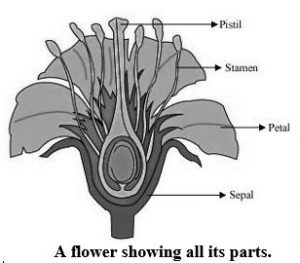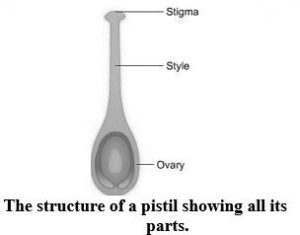NCERT TEXT BOOK EXERCISES
Q1. Correct the following statements and rewrite them in your notebook.
(a) Stem absorbs water and minerals from the soil.
(b) Leaves hold the plant upright.
(c) Roots conduct water to the leaves.
(d) The number of petals and sepals in a flower is always equal.
(e) If the sepals of a flower are joined together, then its petals are also joined together.
(f) If the petals of a flower are joined together, then the pistil is joined to the petal.
Ans. (a) Root absorbs water and minerals from the soil.
(b) Stem holds the plant upright.
(c) Stem conducts water to the leaves.
(d) The number of petals and sepals in a flower may be different in different plants.
(e) If the sepals of a flower are joined together, then its petals may or may not be joined together.
(f) If the petals of a flower are joined together, then the stamen may or may not be joined to the petal.
Q2. Draw (a) a leaf, (b) a taproot, and (c) a flower that you have studied for.
Ans.
(a) 
(b) 
(c) 
Q3. Can you find a plant in your house or in your neighbourhood which has a long but a weak stem ? Write its name. In which category would you classify it ?
Ans. The money plant has a long and weak stem. It comes under the category of climbers. Climbers are plants that readily take support on neighbouring structures as they have a weak stem.
Q4. What is the function of a stem in plant ?
Ans. The main function of a stem in plants is that it helps in the conduction of water and minerals from the roots to the leaves and other parts of plants. It also provides support to branches, leaves, flowers, fruits, and buds of plants.
Q5. Which of the following leaves have reticulate venation ?
Wheat, tulsi, maize, grass, coriander (dhania), China rose
Ans. The leaves of tulsi, coriander, and China rose have reticulate venation, whereas maize, grass, and wheat have parallel venation.
In leaves with reticulate venation, the veins are arranged in a net-like pattern. In parallel venation, the veins are arranged parallel to one another.

Q6. If a plant has fibrous roots, what type of venation are its leaves likely to have ?
Ans. Plants with fibrous roots have parallel venation in their leaves. For example, grass, wheat, maize, etc. have fibrous roots with parallel venation.

Fibrous roots have thin and moderately growing branches arising from the stem. Parallel venation, on the other hand, has leaves in which the veins are arranged parallel to each other.
Q7. If a plant has leaves with reticulate venation, then what kind of roots does it have ?
Ans. Plants with reticulate venation in their leaves are likely to have tap roots. For example, a carrot or a rose plant has leaves with reticulate venation and its roots are called tap roots.

In tap roots, there is one main root known as the ‘tap root’ that grows straight down from the stem. It also has smaller roots known as ‘lateral roots’. In leaves with reticulate venation, the veins are arranged in a net-like pattern.
Q8. Is it possible for you to recognize leaves without seeing them ? How ?
Ans. Yes. We can recognize leaves without seeing them. You can look for the type of roots of the plant and identify the type of leaf. If the plant has fibrous roots, then its leaves have parallel venation, and if the plant has tap roots, then its leaves have reticulate venation.
Q9. Write the names of the parts of a flower.
Ans. A flower consists of sepals, petals, stamens, and pistils. A stamen has two parts called the anther and the filament. A pistil has three parts called the stigma, style, and ovary.

Q10. Which of the following plants have you seen? Of those that you have seen, which ones have flowers ?
Grass, maize, wheat, chilli, tomato, tulsi, pipal, shisham, banyan, mango, jamun, guava, pomegranate, papaya, banana, lemon, sugarcane, potato, groundnut.
Ans. The given examples are flowering plants. But, in some plants such as tulsi, pipal, sugarcane, etc. the flowers are not visible. They are so small that they cannot be seen with naked eyes.
Q11. Name that part of plants which produces food. Name this process.
Ans. The part of plants which prepares food is the leaf. Leaves of a plant prepare food in the presence of sunlight. The process of making food by utilizing water and carbon dioxide in the presence of sunlight is called photosynthesis.
Q12. In which part of a flower, you are likely to find the ovary ?
Ans. Pistil is the part of the flower that contains the ovary.

Q13. Name two flowers each with joined and separated sepals.
Ans. Flowers with joined sepals are Periwinkle (Sadabahar) and Hibiscus (China rose).
Flowers with separated sepals are Rose and Magnolia.








